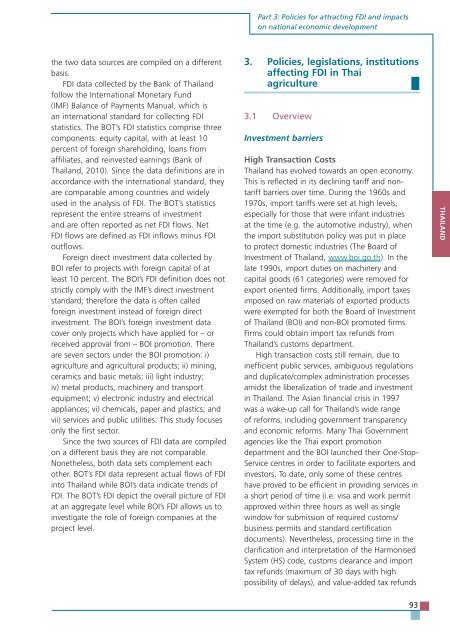TRENDS AND IMPACTS OF FOREIGN INVESTMENT IN DEVELOPING COUNTRY AGRICULTURE
TRENDS AND IMPACTS OF FOREIGN INVESTMENT IN DEVELOPING COUNTRY AGRICULTURE
TRENDS AND IMPACTS OF FOREIGN INVESTMENT IN DEVELOPING COUNTRY AGRICULTURE
You also want an ePaper? Increase the reach of your titles
YUMPU automatically turns print PDFs into web optimized ePapers that Google loves.
the two data sources are compiled on a different<br />
basis.<br />
FDI data collected by the Bank of Thailand<br />
follow the International Monetary Fund<br />
(IMF) Balance of Payments Manual, which is<br />
an international standard for collecting FDI<br />
statistics. The BOT’s FDI statistics comprise three<br />
components: equity capital, with at least 10<br />
percent of foreign shareholding, loans from<br />
affiliates, and reinvested earnings (Bank of<br />
Thailand, 2010). Since the data definitions are in<br />
accordance with the international standard, they<br />
are comparable among countries and widely<br />
used in the analysis of FDI. The BOT’s statistics<br />
represent the entire streams of investment<br />
and are often reported as net FDI flows. Net<br />
FDI flows are defined as FDI inflows minus FDI<br />
outflows.<br />
Foreign direct investment data collected by<br />
BOI refer to projects with foreign capital of at<br />
least 10 percent. The BOI’s FDI definition does not<br />
strictly comply with the IMF’s direct investment<br />
standard; therefore the data is often called<br />
foreign investment instead of foreign direct<br />
investment. The BOI’s foreign investment data<br />
cover only projects which have applied for – or<br />
received approval from – BOI promotion. There<br />
are seven sectors under the BOI promotion: i)<br />
agriculture and agricultural products; ii) mining,<br />
ceramics and basic metals; iii) light industry;<br />
iv) metal products, machinery and transport<br />
equipment; v) electronic industry and electrical<br />
appliances; vi) chemicals, paper and plastics; and<br />
vii) services and public utilities. This study focuses<br />
only the first sector.<br />
Since the two sources of FDI data are compiled<br />
on a different basis they are not comparable.<br />
Nonetheless, both data sets complement each<br />
other. BOT’s FDI data represent actual flows of FDI<br />
into Thailand while BOI’s data indicate trends of<br />
FDI. The BOT’s FDI depict the overall picture of FDI<br />
at an aggregate level while BOI’s FDI allows us to<br />
investigate the role of foreign companies at the<br />
project level.<br />
Part 3: Policies for attracting FDI and impacts<br />
on national economic development<br />
3. Policies, legislations, institutions<br />
affecting FDI in Thai<br />
agriculture <br />
3.1 Overview<br />
Investment barriers<br />
High Transaction Costs<br />
Thailand has evolved towards an open economy.<br />
This is reflected in its declining tariff and nontariff<br />
barriers over time. During the 1960s and<br />
1970s, import tariffs were set at high levels,<br />
especially for those that were infant industries<br />
at the time (e.g. the automotive industry), when<br />
the import substitution policy was put in place<br />
to protect domestic industries (The Board of<br />
Investment of Thailand, www.boi.go.th). In the<br />
late 1990s, import duties on machinery and<br />
capital goods (61 categories) were removed for<br />
export oriented firms. Additionally, import taxes<br />
imposed on raw materials of exported products<br />
were exempted for both the Board of Investment<br />
of Thailand (BOI) and non-BOI promoted firms.<br />
Firms could obtain import tax refunds from<br />
Thailand’s customs department.<br />
High transaction costs still remain, due to<br />
inefficient public services, ambiguous regulations<br />
and duplicate/complex administration processes<br />
amidst the liberalization of trade and investment<br />
in Thailand. The Asian financial crisis in 1997<br />
was a wake-up call for Thailand’s wide range<br />
of reforms, including government transparency<br />
and economic reforms. Many Thai Government<br />
agencies like the Thai export promotion<br />
department and the BOI launched their One-Stop-<br />
Service centres in order to facilitate exporters and<br />
investors. To date, only some of these centres<br />
have proved to be efficient in providing services in<br />
a short period of time (i.e. visa and work permit<br />
approved within three hours as well as single<br />
window for submission of required customs/<br />
business permits and standard certification<br />
documents). Nevertheless, processing time in the<br />
clarification and interpretation of the Harmonised<br />
System (HS) code, customs clearance and import<br />
tax refunds (maximum of 30 days with high<br />
possibility of delays), and value-added tax refunds<br />
93<br />
THAIL<strong>AND</strong>


